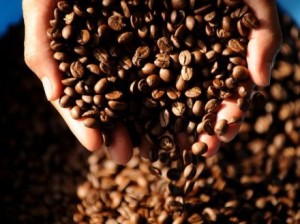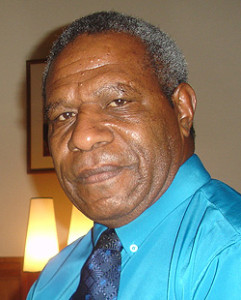Grown almost entirely without pesticides in small village gardens, PNG coffee is cherished by aficionados around the world for its delicate fruity ‘winey’ and smooth caramel aftertaste. Ian Neubauer looks at how the coffee bean reaches its major markets overseas.

PNG Coffee beans, Credit: AFP
Some 2.5 million Papua New Guineans rely on coffee cultivation and processing as their primary source of income in the highlands of PNG’s which provide ideal conditions for Arabica coffee trees. It earns some US$378 million a year for the country, but has the potential to earn a lot more
Lack of investment showing
‘Quality control is our biggest challenge and unfortunately we are seeing depreciating standards in PNG,’ says Joeri Kalwij, Deputy Country Manager at Monpi Coffee Exports in Goroka.
‘For a standard grade of coffee, 85% of beans should have no more than 70 defects per kilogram and in PNG we are lucky to get beans at that level. But we are quite strict.
‘We demand a certain quality and if we don’t get it, we reject it.’ (A lack of investment in new coffee trees in PNG, many of which are more than 40 years old, is the cause of declining bean quality, according to a recent World Bank report.)
‘We have just purchased a new Diedrich 50kg roaster from the US. It will increase our roasting capacity to 300 tonnes a year and allow us to explore the possibilities of exporting our ground coffee overseas.’
‘We’ve invested a lot of money and effort to meet the quality standards of traders who buy our beans,’ Kalwij says.
Roasting

Jerry Kapka, CEO, Kongo Coffee
The next stage in the process—roasting—generally takes place in the country of consumption, as roasted coffee has a limited shelf life.
However, some processors like Kongo Coffee in Simbu Province also roast a small amount of green beans for the domestic market—50 tonnes per year (around one per cent of production)—and packages it as ground coffee for distribution in supermarkets, restaurants and hotels around PNG.
‘We have just purchased a new Diedrich 50kg roaster from the US,’ says Kongo managing director Jerry Kapka.
‘It will increase our roasting capacity to 300 tonnes a year and allow us to explore the possibilities of exporting our ground coffee overseas.’
Blends
There’s a second important reason the vast majority of green beans are roasted in their country of consumption: it allows local roasters to mix beans from different parts of the world and create ‘blends’ that cater to local tastes.
Or, in the case of ‘single-origin’ coffee, it allows them to roast beans using their expertise and package roasts under their brand names.
‘For the past 20 years coffee from Papua New Guinea has been really consistent. The processors there do a great job,’ says Gavin Folden, co-founder of Single Origin Roasters in Sydney.
‘From someone who has never been to New Guinea,’ he continues, ‘all I know it that it’s an agricultural product grown by a pretty committed farming mob.’
Australian market
Enter the WR Carpenter Group, a Mt Hagen-based coffee processor that not only grows it owns beans in the Western Highlands Province of PNG but distributes and markets green beans to roasters in Australia.
‘Much more effort has to be made to promote PNG and its products in a positive direction, to show them it’s a tropical paradise with one of the best climates in the world to grow coffee, and that by drinking PNG coffee, they are helping people have better livelihoods there.’
‘For more than 25 years we used to sell coffee to roasters in Australia through traders,’ says Ajit Kalluvadi, general manager of Carpenter Products in Melbourne.
‘But, in 2010, we took control of distribution and marketing so we could add more value and build recognition for our brand directly with consumers.
‘We have been very successful,’ he says.

Carpenter’s Sigri label
‘We are importing three to four times what we were importing when we started. We have two warehouses in Melbourne, one in Brisbane and another in Sydney.’
Image
Yet Kalluvadi acknowledges there remains mountains to move in terms of consumer perception.
‘Most roasters in Australia are well aware of the quality of PNG coffee. But the end user, they have heard all these bad stories about PNG and see it as a bit of a mystery. In terms of marketing, that’s a huge drawback,’ he says.
‘Much more effort has to be made to promote PNG and its products in a positive direction, to show them it’s a tropical paradise with one of the best climates in the world to grow coffee, and that by drinking PNG coffee, they are helping people have better livelihoods there.’
Europe
While 22% of PNG’s green beans are exported to Australia, nearly twice that amount–40%–is exported to Europe.
From there the beans are transported to blending plants like the Supremo Blending Unit in Antwerp where they’re mixed with green beans from other parts of the world.
‘PNG coffee plays an important part of many blends because it adds a fruity taste to coffee.’
‘We control the supply chain from one end to the other, starting at the milling stage, turning, sorting it, shipping it and blending it,’ says Ramon Esteve, a director with Econ, which owns the Supremo plant, Monpi Coffee Exports in PNG, and processing operations in 21 other coffee producing countries around the world.
‘PNG is a small producer and represents a very small part of our business, below one per cent. Importing it is extremely difficult with the roads being what they are and logistics are a real pain,’ he says.
‘But it’s considered a specialty coffee and in demand by roasters and we always try to satisfy our customers needs.’
Fruity taste
Adds Michael Wheeler, the PNG Coffee Industry Corporation’s London-based overseas representative: ‘PNG coffee plays an important part of many blends because it adds a fruity taste to coffee. For example, Brazilian coffee can have a very harsh or earthy taste, but beans from PNG will lighten the blend and make it more palatable for most people.’
‘In the UK and Russian market, most of it is turns into soluble coffee,’ says Esteve. ‘But if you look at Northern Europe—Scandinavia and Germany—they tend to have filter coffee. And, as you move south into Italy and Greece, it’s all about the espresso.’
In the UK, niche demand also exists for the best of the best PNG single-origin coffee.
‘It is one of those seasonal coffees our supermarkets will pick it up for 6–8 weeks a year because it’s seen as quite an exotic coffee they can use to attract customers,’ says the CIC’s Wheeler.
From red bean to roasting: creating the perfect cuppa
- The trees require relatively low maintenance during their five-year growth phase, although labour requirements peak from April to August, when cherry beans are harvested by hand and dried in the sun.
- The red beans, as they are called, are then transported to mills where they are dehusked, sorted and graded–often in the presence of growers, who are then paid according to the weight and quality of their crop.
- The green beans, as they are now called, are transported to warehouses for bagging, weighing and storage.
- Warehouse features include climate control, heavy duty moisture extraction fans and a computerised inventory system that records excruciatingly detailed data and tasting notes on every 69kg sack of beans.
- The next step is winnowing, a process where air current is used to separate abnormally heavy or light beans, followed by sieving, where beans are sorted for size, and a hand-sorting phase where defective beans are removed by armies of women.








Speak Your Mind